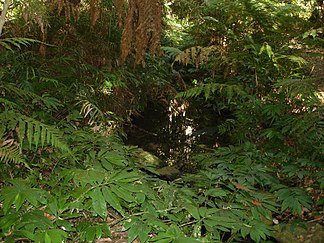Bunya Mountains
| Bunya Mountains | ||
|---|---|---|
|
A stream in the Bunya Mountains National Park |
||
| Highest peak | Mount Kiangarow ( 1135 m ) | |
| location | Queensland | |
|
|
||
| Coordinates | 26 ° 50 ′ S , 151 ° 33 ′ E | |
| rock | Volcanites | |
| Age of the rock | 23–24 million years ago | |
The Bunya Mountains are a mountain range in Queensland , Australia , formed 23 to 24 million years ago by lava emerging from crevices and shield volcanoes .
location
The mountain range is part of the Great Dividing Range in southern Queensland, which extends from the north of Darling Downs at Bell to Dalby , Kingaroy and Nanango . The highest mountains in the range are Mount Kiangarow with 1135 meters and Mount Mowbullan with 1086 meters. In the northeast, the Bunya Mountains form the watershed of the Burnett River and in the southwest of the Condamine River .
geology
The first lava of the Bunya Mountains flowed over land that consisted of sediments from eroded mountains formed 200 to 180 million ago in the Mesozoic and partially Paleozoic . First, lava flowed into the valleys and then shield volcanoes formed. The lava, which solidified to basalt, extended over the entire area, except for an outflow of trachyte on the southwestern flank of the mountains. The volcanoes formed an area that stretches from the southern Main Range from the New South Wales border northward to Kingaroy because the lava was of low viscosity . The deposited lava is different and reaches a thickness of 700 meters at Mount Kiangarow and was originally 1100 meters thick. On average, the layer height of the basalt is 3 to 6 meters.
Other volcanoes that formed near the Bunya Mountains at the same time include the Focal Peak Volcano volcanic complex near Mount Barney and Tweed Volcano , which formed the Lamington Plateau and the Border Range .
The volcanoes were created by a hotspot that lay under the Bunya Mountains . At the time the volcanoes were formed, the climate was cool and as the Australian continent migrated north it became dry. Warm and subtropical rainforests were pushed back by the developing drought. It spread eucalyptus and rainforests retreated to areas with higher rainfall back.
Aboriginal
The Queensland Araucaria ( Araucaria bidwillii ) - locally called Bunya Pine - was of great importance to the Aborigines . It is a tree of the Bunya Mountains that can grow up to 30 to 45 meters high, has a trunk circumference of 1.5 m and prefers basaltic soils. The bunya nut, which reaches the size of a soccer ball, weighs one kilogram and contains 100 to 200 seeds, was collected together as bush food by the Aborigines in the area of north-south Queensland from December to March . The seeds were eaten raw or roasted, made into flour or baked into bread. The nut was also used in ceremonies, trade, weddings and other occasions. The wood of the tree has recently been used to build guitars.
tourism
Large areas of the Bunya Mountains are located in the protected Bunya Mountains National Park , Queensland's second oldest national park, established in 1908. The park has picnic areas, hiking trails, campsites and holiday homes.
Parrots and flat-tailed parakeets , wallabies , grouse , koalas , echins and possums can be found in the mountains .
Web links
- qld.gsa.org.au (PDF; 241 kB): Location map of the volcanic area of The Bunya Mountains
- Bunya Mountains Gathering , Queensland Museum's Find out about
Individual evidence
- ↑ a b c d e qld.gsa.org.au ( Memento of the original from October 24, 2009 in the Internet Archive ) Info: The archive link was inserted automatically and has not yet been checked. Please check the original and archive link according to the instructions and then remove this notice. (PDF; 241 kB): The Bunya Mountains , in English, accessed on January 24, 2012
- ↑ dpi.qld.gov.au ( Memento of the original from May 11, 2012 in the Internet Archive ) Info: The archive link was inserted automatically and has not yet been checked. Please check the original and archive link according to the instructions and then remove this notice. : Bunya Pine , accessed January 24, 2012
- ↑ anpsa.org.au : Bunya Feast , in English, accessed on January 24, 2012
- ↑ sgapqld.org.au ( Memento of the original from September 24, 2015 in the Internet Archive ) Info: The archive link was inserted automatically and has not yet been checked. Please check the original and archive link according to the instructions and then remove this notice. : Bunya Nuts , accessed January 24, 2012




